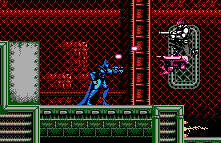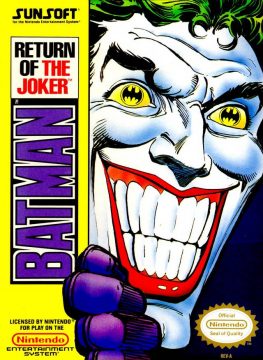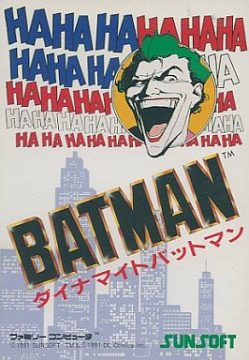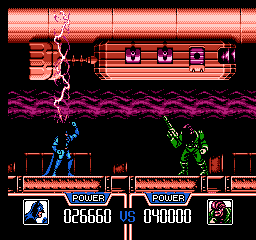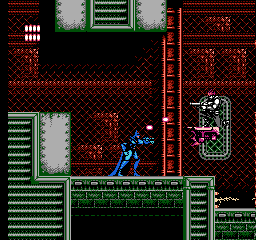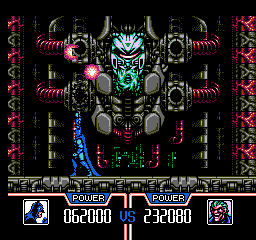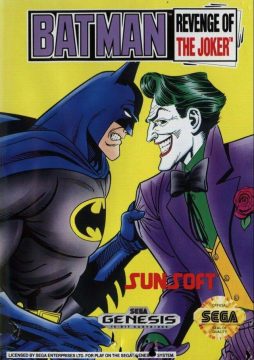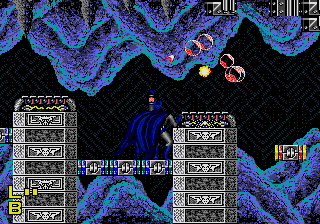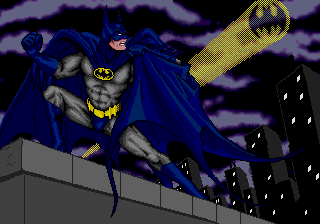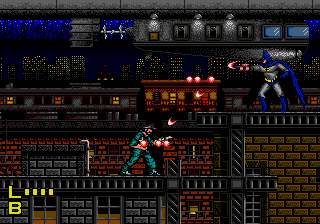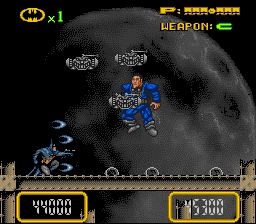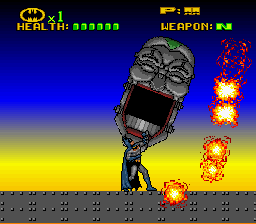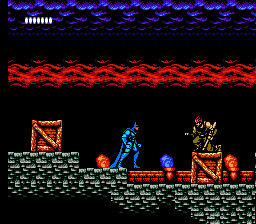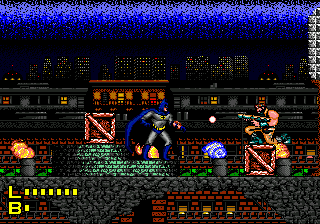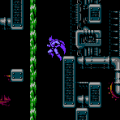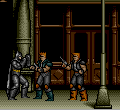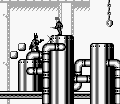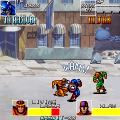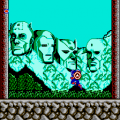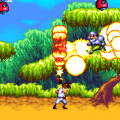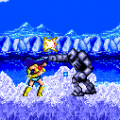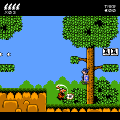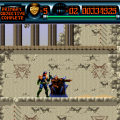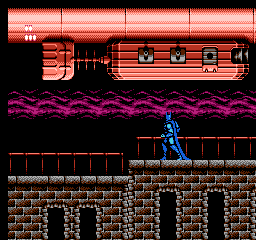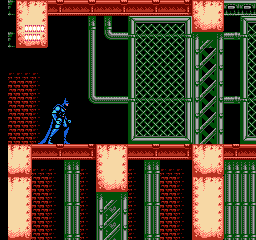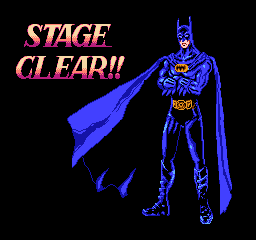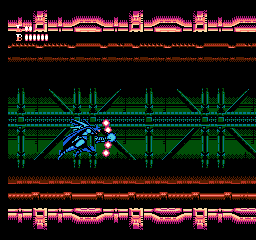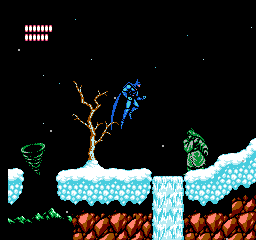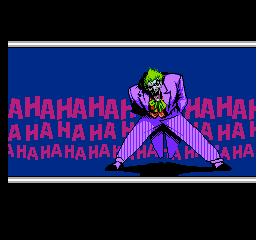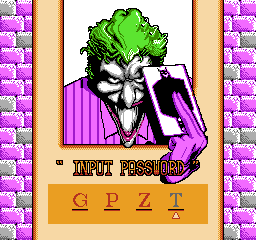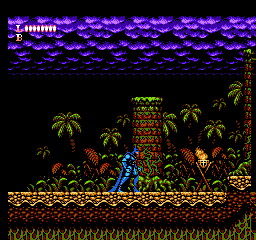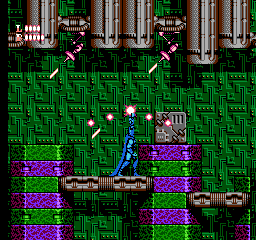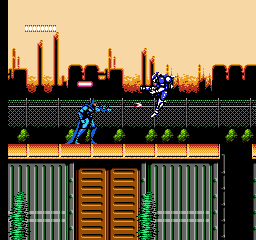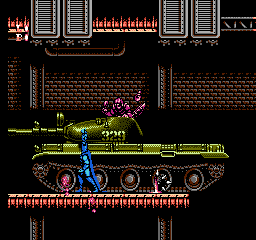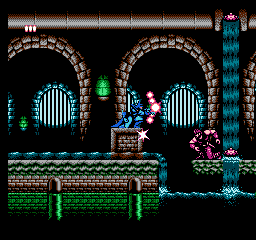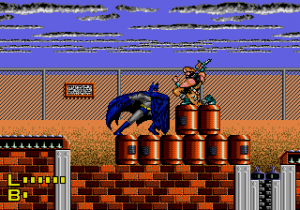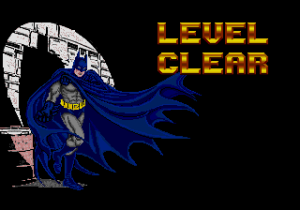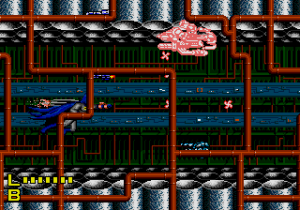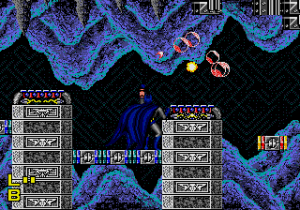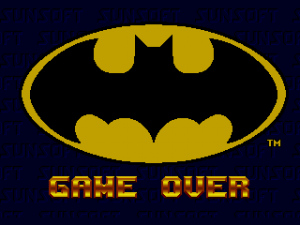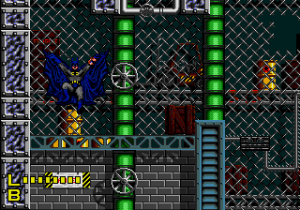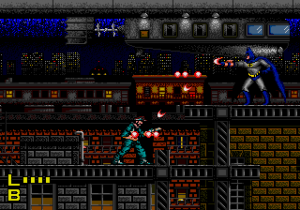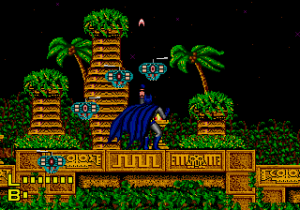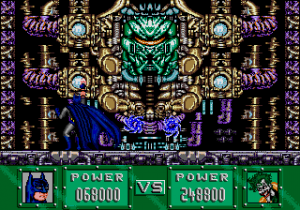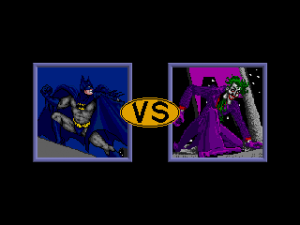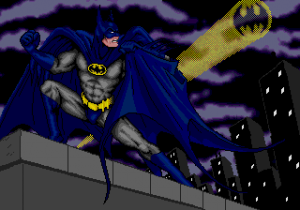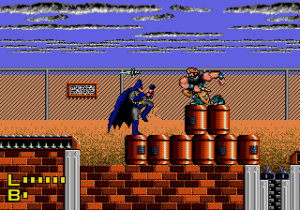Almost a year after Batman: Return of the Joker‘s release, Sunsoft used the same title for an NES game. In Japan it is called Dynamite Batman, and it’s once again completely different from the Game Boy outing. Here, Sunsoft prioritized the game’s graphics and sound above everything else. This is one of the most technically impressive games on the NES, with multiple layers of parallax scrolling, an intense, bass-heavy soundtrack, very colorful backgrounds and huge sprites. The graphics were the main focus for the game’s advertising, with extra care taken to point out that you really are looking at images of a game running on an NES. It was worth the effort, as both visually and aurally it can almost pass for an early Genesis game.
Interestingly, however, Batman still fights with firearms, this time via a gun attached to his wrist. He can also perform a slide attack by pressing down and jump. His gun can be changed to several other weapon types by picking up icons with letters on them. These weapons can also be charged up by holding down the attack button for various enhanced effects.
Unfortunately, the simplicity of the game’s level design makes only the C and N weapons (Crossbow and Sonic Neutralizer according to the manual) actually useful. The crossbow is amazing, it kills almost every enemy with one hit, and when charged it shoots out a spread of projectiles which then ricochet off walls. Some enemies will also drop glowing orbs. You can collect eight of these to turn Batman gold and equip him with a shoulder-mounted energy canon like something out of Contra: Hard Corps for a short time. Still, even the regular crossbow weapon is overkill for the game’s enemies.
These armaments and great graphics, unfortunately, are also the game’s greatest flaw. Between the powerful weapons and huge sprites, you’ll never find yourself fighting more than two foes at a time, with most being defeated very shortly after they appear. The huge characters also limit the game’s platforming, making for a very simple game until the second half of the final level.
Still, despite the low difficulty, it’s a lot of fun to play because of the great graphics and music. Like in Batman: The Video Game, the music was handled by Nobuyuki Hara and Naoki Kodaka, and both brought their A game. Each track is short, but has the complexity and intensity we’ve come to expect from their work on previous Batman games.
The boss fights are a departure from the norm. When they begin, Batman dramatically calls and absorbs lightning from the sky. Then his and the boss’ life are represented by a large number of hit points rather than energy bar used in the game proper. This lets Batman take way more punishment than he can during the rest of the game, and allows for large and aggressive bosses that attack relentlessly. It’s a great idea, but unfortunately the boss patterns are simple enough that you’ll get bored of them long before they’re defeated. The final confrontation with the Joker is interesting though, he’s stationed in a large Geiger-inspired fortification that would be right at home in Contra or Gunforce 2.
Despite the game’s relative simplicity, it holds up as one of the better Batman games until Batman: Arkham Asylum‘s release in 2009. The controls are very tight, making it easy to navigate the levels and charge your weapons up quickly. While the game is relatively short, each level looks totally different from the rest, and there are even two side-scrolling shooter levels to add some variety. These are the most graphically impressive levels in the game due to the speed and number of parallax layers for an NES title. There are even passwords to let you skip levels if you don’t want to do the entire game in one go. Sunsoft was doing the impossible here. While other publishers like Ocean and Acclaim were dropping awful games based on movies left and right, Sunsoft now had several good Batman games under their belt.
Batman: Return of the Joker was marketed as having “looks at hot as 16-bit!” It was a pretty accurate description, as the NES game’s backgrounds really are stunning. So it’s easy to understand why Sunsoft would want to release this game on the Genesis. This version of the game was developed by Ringler Studios and was released only in the US in 1992, with the subtitle changed to Revenge of the Joker. This was just a few months after the NES game appeared, and the short development time quickly becomes apparent when playing the game.
Batman: Revenge of the Joker‘s level structure, enemies, and weapons are mostly identical to what was seen on the NES. Besides being able to slide, however, players now have a melee attack too: Batman can kick enemies at the push of a button. This is very useful, since enemies are significantly more aggressive here than they are in the NES game, often closing in so quickly that it can be almost impossible to get away and aim your weapons efficiently.
Besides the extra aggressive enemies, everything else has received a difficulty increase as well. As an example, the two auto-scrolling segments in level four both move slightly faster, with added obstacles in the elevator stage. The gargoyles in the first level are much deadlier than in the NES game as well.
On the surface, it sounds like these changes make for a worthy upgrade to the mechanics of the NES version. Unfortunately, despite these additions the Genesis version is actually inferior to the original. While the new Batman sprite is awkward, and the graphics are washed out and garish compared to the detailed look Sunsoft went for with the NES version, the most immediate issue is the sound. The arrangements are the same as the NES game, but it’s one of the tinniest soundtracks on the Genesis. The music was produced by Tommy Tallarico, and is a huge misstep in between his simple but effective work on Wings of Fury and his excellent soundtrack for The Terminator on Sega CD.
The sound effects are equally tinny and weak, lacking the explosive punch of the NES game. It’s especially baffling since Sunsoft regular Naoki Kodaka delivered a great soundtrack to their previous Batman Genesis game in 1990. While Tallarico was a relatively new talent at the time, it was still a mistake to reuse the same arrangements from the NES rather than going for something more suited to the Genesis’ sound. Given the short amount of time between the NES and Genesis games coming out, however, it’s a safe bet these issues are due to Sunsoft rushing it out the door and not Ringler Studios itself.
What makes Revenge of the Joker really tedious, however, are its controls. They can be unresponsive, and you can’t charge up your weapon right after you’ve been hit, while crouching, or doing anything else other than standing still for a second and then initiating the charge. Even worse, your weapons are much weaker here, making the powerful crossbow item the only weapon worth using. Kicking an enemy does as much damage as the crossbow, but unfortunately the hit detection for the jump kick makes it much more challenging to connect with than it should be. Often you’ll end up taking damage even after jump kicking successfully. So while the attempts at making the game more difficult are appreciated, without the controls to back it up the game ends up being more frustrating than fun. As a final insult, if you don’t move for a few seconds Batman will draw his cape across his face and look around menacingly. This causes him to lean forward enough that you can end up taking damage while waiting in a safe spot to avoid projectiles and enemies!
Batman: Revenge of the Joker is very disappointing compared to the polished action games Sunsoft had become known for on the NES. It’s unfortunate this was so rushed, as it would have been great to see what Ringler Studios could have accomplished with more time. Instead, we get a game with washed out graphics, weak sound, and badly implemented controls. The hasty nature of this release is also made clear by the graphics and music noticeably getting worse the further you get in the game, to the point where the final level is an embarrassment compared to the NES version.
At almost the same time, Sunsoft had ICOM Simulations (Shadowgate, Shapeshifter) working on another version of Batman: Revenge of the Joker, to be released on the SNES before its cancellation. A prototype of the game surfaced in the early 2000s. Unlike the Genesis release, there are some significant changes to the boss designs, but many of the balance issues from the Genesis are made even worse here. While there isn’t much to say about it as it’s clearly unfinished, it’s doubtful it would have made for a much better game than what we got from Ringler Studios. Many of the core control and hit detection issues from the Genesis game are present and enemies are even more aggressive and numerous. It’s easy to see why Sunsoft gave up on this one. Hilariously, despite David Whittaker (Xenon II: Megablast) working on the game’s music, Sunsoft again opted for a replication of the NES game’s soundtrack, with the result being about as bad as it is on the Genesis.
The Batman: Return of the Joker name went through a brief and almost glorious history. From a throw-away Game Boy cash in that ended up being fun thanks to Sunsoft’s talent to a great NES game, it seemed like there was a lot of promise for a series. But two rushed ports for the Genesis and SNES (the latter of which didn’t even get released) killed it less than a year after the NES game came out. But despite the badness of Revenge of the Joker, Sunsoft’s Game Boy and NES takes on Batman hold up and are still worth a play today.
Screenshot Comparisons
